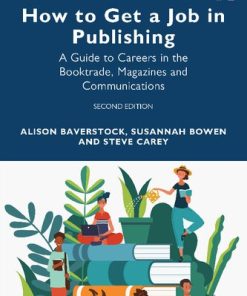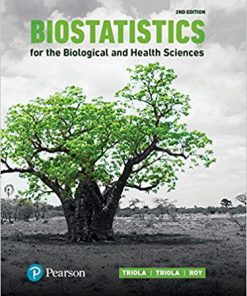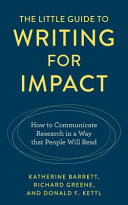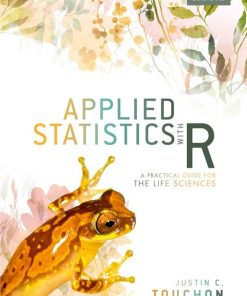(Ebook PDF) How To Publish In Biological Sciences A Guide For The Uninitiated 1st edition by John Measey 100054835X 9781000548358 full chapters
$50.00 Original price was: $50.00.$25.00Current price is: $25.00.
How To Publish In Biological Sciences: A Guide For The Uninitiated 1st edition by John Measey – Ebook PDF Instant Download/DeliveryISBN: 100054835X, 9781000548358
Full download How To Publish In Biological Sciences: A Guide For The Uninitiated 1st edition after payment
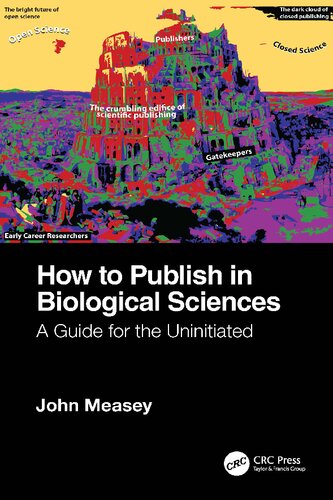
Product details:
ISBN-10 : 100054835X
ISBN-13 : 9781000548358
Author: John Measey
This book is a guide specifically for Early Career Researchers on how to publish in the Biological Sciences, whether that be your first manuscript or if you’re already experienced – there’s something for everyone. Following on from How to Write a PhD in Biological Sciences: A Guide for the Uninitiated, it will guide you through taking your manuscript to publication in peer-reviewed journals and disseminating your research more broadly. It talks you through the peer-review process, including how to respond to reviewers’ comments, the meaning and importance of Impact Factors and how to get citations. It also explores the challenges in the academic community around Open Access and other debates, including transparency, overlay journals, paywalls, publication bias, predatory journals and the dangers of bullying. Whether you are a student just completing your studies, or a supervisor struggling with rejections, this book will provide the insider information you need to get ahead.
How To Publish In Biological Sciences: A Guide For The Uninitiated 1st Table of contents:
I Getting ready for submission
1 The transition from closed to open
1.1 Three fundamentals of publishing in Biological Sciences
1.1.1 Gatekeepers
1.1.2 Is it possible to do without the publishers?
1.2 Peer review
1.3 Impact Factor
1.4 Citations
1.5 Open Science – a vision of the future
2 What is a scientific journal for?
3 What is peer review?
3.1 History of peer review
3.1.1 How high is the peer review bar?
3.2 Who are your peers?
3.2.1 The role of the editor
3.2.2 Who are the Gatekeepers (Advisory and Editorial Boards)?
3.3 Reviewer models
3.3.1 Blind reviewers
3.3.2 Double blind reviewers
3.3.3 Triple blind reviewers
3.3.4 Open reviewers
3.3.5 Public reviewers
3.4 Learn more about peer review by doing it
3.4.1 What do peer reviewers get out of participation?
4 Transparency in publishing
4.1 Removing the prejudice around confirmatory bias
4.1.1 Accepting the alternative hypothesis
4.1.2 Inadvertent bias
4.1.3 Novel research
4.2 Introducing transparency in peer review
4.2.1 Moving towards Open Science
5 What can you publish?
5.1 Standard articles
5.2 Reviews
5.3 Commentaries or opinion pieces
5.4 Letters
5.5 Editorials
6 What is Impact Factor, and why is it so important?
6.1 From a simple score to a way of life
6.2 Five-year Impact Factor
6.3 What can you do if you publish a journal with high IF?
6.4 Why is IF so important?
6.5 Editors try to increase IF
6.5.1 Negotiating your IF
6.6 Push back against IF
7 When should you be an author?
7.1 Ghost authorship
7.1.1 Paper mills
7.2 Honorary authorship
7.3 A need for transparency – DORA
7.4 Who should be an author?
7.4.1 Rescognito, ORCID and the CRediT Contributor Checklist
7.4.2 If you suspect irregularities in authorship
8 Citations and metrics
8.1 What are your citation metrics?
8.1.1 Total citations
8.1.2 H-index
8.1.3 G-index
8.1.4 R-index
8.1.5 a-index
8.1.6 i10-index
8.1.7 Other metrics
8.2 How to increase your citations
8.2.1 Media release
8.2.2 Social media
8.2.3 Popular articles
8.2.4 Self-citations
8.2.5 Citing papers submitted and in press
8.2.6 Presenting the results of your paper at a conference
8.2.7 Organising symposia and having special issues
8.2.8 Traditional media
8.2.9 Not-so-legitimate ways of increasing citations
8.3 Well-cited articles are likely to be cited more
9 Growing your network
9.1 What to look for in a mentor
9.2 Questions to put to your mentor
9.3 The importance of networks in your academic career
9.3.1 Calculating the size of your network
9.3.2 Using social networks to grow your network
9.4 Creating your own website
10 Preprints
10.1 What are preprints?
10.2 Who posts preprints on bioRxiv?
10.3 Why might you want to post a preprint?
10.4 Upload newer versions
10.5 Will you have to post a preprint?
10.6 Could these comments pages really replace peer review?
10.7 Preprints are here to stay
10.8 When should evaluation end?
10.9 Are preprints published?
10.10 The exciting new world of Overlay Journals
10.10.1 What do traditional publishers think of ‘Overlay Journals’?
10.10.2 What is happening in Biological Sciences?
10.10.3 Preregistration and a commitment to publish
10.10.4 Choose non-profit preprint servers
10.11 Peeriodicals – another twist on the idea of an Overlay Journal
10.12 Should you submit your manuscript as a preprint?
10.12.1 For
10.12.2 Against
II Publishing your work
11 Writing your cover letter
11.1 Do editors read cover letters?
11.2 What not to do in your cover letter
12 Suggesting reviewers
12.1 Who should you not suggest?
12.2 Who should you oppose?
12.3 Who will the editor use?
13 Choosing the right journal
13.0.1 Indexing
13.0.2 The subject area
13.0.3 The journal scope and readership
13.0.4 Ownership of the content
13.0.5 Current contents
13.0.6 Society journals
13.0.7 Transparent credibility
13.0.8 Knowing the journal from the inside
13.0.9 Is there a special issue?
13.0.10 Avoiding the predators
13.0.11 Financial considerations to publishing
13.0.12 Type of peer review
13.0.13 Time to first decision
13.0.14 Open Access
13.0.15 Page charges
13.0.16 Fee waiver
13.0.17 Impact Factor
13.0.18 No Impact Factor journal
13.1 Shortlist
14 Open Access or a paywall for your manuscript?
14.1 Closed Access: i.e. The Paywall
14.2 Open Access (OA)
14.2.1 Gratis OA
14.2.2 Libre OA
14.2.3 Green OA
14.2.4 Bronze OA
14.2.5 Delayed OA
14.2.6 Gold OA
14.2.7 Hybrid OA
14.2.8 Platinum or Diamond OA
14.2.9 Black OA
14.2.10 Grey OA
14.3 Supplementary information and data
14.4 Unsure what you can legally do with a published paper?
15 Submitting a paper to a journal for peer review
15.1 A typical submission workflow
15.1.1 Remember that peer review is conducted by humans
16 Expectations of peer review?
16.1 What are peer reviewers asked to do?
16.1.1 The review
16.1.2 Reviewer’s confidential comments to the editor
16.1.3 Reviewer’s opinion and the editorial decision
16.2 What do good reviews look like?
16.2.1 The myth of the ‘shit sandwich’
16.3 What are reviewers not asked to do?
17 Receiving the editor’s decision
17.1 What to expect in your decision letter
17.1.1 The desk rejection
17.1.2 Take a rejection seriously
17.1.3 Time taken to receive your decision
17.2 What to do when you receive your reviewer comments
17.3 Responding to reviewers’ comments with a rebuttal
17.3.1 What if you don’t agree with a reviewer?
17.3.2 When reviewers ask for additional analyses or experiments
17.3.3 When reviewers don’t agree
17.3.4 More than two rounds of peer review
17.3.5 Is your reviewer being unprofessional?
17.3.6 Appealing against a decision that you think is unfair
18 Why should an editor read your submission?
18.1 Why is reading so important?
18.2 Editors must be prepared to read
18.3 I’ve been on the other end too
18.4 There is worse that goes on in economics
18.5 Summing up on editorial blunders
III After your paper is accepted
19 Now that your manuscript has been accepted
19.1 The Version of Record
19.1.1 What does having a VoR mean?
20 Once your paper is accepted
20.1 Take your time with proofs
20.2 The DOI for your paper
20.2.1 DOI tools
20.3 Add your paper to your ORCID account
20.4 Once you have a publication date
20.5 On the day you publish
21 Writing a press release
22 Why write a popular article?
22.1 Here’s a quick guide on how to get started writing a popular article.
23 Altmetrics from traditional and social media
IV Further challenges in academia
24 Is Open Access good?
24.1 So what is Open Access?
24.1.1 PLOS ONE
24.2 So does that mean that OA journals are now free?
24.3 The wicked problem
24.3.1 Choosing open source for Open Science
24.4 Making the change
25 How to conduct peer review
25.1 Novelty or repeatability?
25.2 Parts of your review
25.2.1 A positive appraisal of the study
25.2.2 Major comments
25.2.3 Minor concerns
25.3 The spirit of peer review
25.3.1 There are ethical considerations for reviewers
25.3.2 Remain objective and rational
25.3.3 Remember to accentuate the positive
25.3.4 How long should your review be?
25.3.5 What to do if you suspect fraud?
25.3.6 Further help with conducting peer review
26 The problems with peer review
26.1 Upsetting comments
26.2 Ad hominem attacks
26.3 Demonstrated biases in peer review
26.4 All reviews are not equal
26.5 Decisions rest with editors
26.6 The social side of peer review
26.6.1 The ‘invisible hand’ of peer review
26.7 Fixing peer review
27 What are predatory journals?
27.1 How can you tell whether or not a journal is predatory?
27.1.1 How to spot a predatory journal
27.1.2 Where’s the harm in publishing with predators?
27.2 What to do if you have already published in a predatory journal
28 Why did some journals go behind paywalls?
28.1 Why don’t all society journals publish independently?
28.2 Why is there so much money in publishing science?
28.2.1 How could such a profitable business lead to making a loss?
28.3 What will it take to break the vicious cycle?
28.3.1 A role for scholarly societies and libraries
28.4 Can we afford not to change?
28.5 Societies need money. Editors can’t be publishers.
28.6 A paywall is never acceptable wherever you put it
28.7 The answer lies inside our university libraries
28.8 Do we need a fancy layout?
28.9 Giving up the obsession with metrics
29 Are researchers writing more, and is more better?
29.0.1 At what rate is the literature increasing?
29.0.2 If more is being published, will Impact Factors increase?
29.1 Are some authors unfeasibly prolific?
29.2 Salami-slicing
29.3 Is writing a lot of papers a good strategy?
29.3.1 Natural selection of bad science
29.3.2 Does all of this tell us that publishing more is bad?
30 When should you correct or retract your paper?
30.1 Making a correction to a published paper
30.2 Expression of concern
30.3 A retraction is unusual
30.3.1 How do you know if a paper you cited is later retracted?
30.3.2 Notification of retraction
30.4 Retraction Watch
30.5 Fabrication of data
30.5.1 Who is responsible?
30.6 What to do if you suspect others
30.7 Confirmation bias and the paradox of high-flying academic careers
31 Are you bullying or being bullied?
31.1 How to spot a bully
31.2 What to do about bullying
31.3 What to do if the procedure against bullying at your institution doesn’t work
32 Keeping track of your mental health
32.1 Being physically active improves mental wellbeing
33 Habilitation, DSc and Tenure
33.1 Habilitation
33.2 Doctor of Science (DSc)
33.3 Tenure
People also search for How To Publish In Biological Sciences: A Guide For The Uninitiated 1st:
where to study biological sciences
how to publish a scientific paper
biological sciences in public health
what is included in biological sciences
how to publish in a scientific journal
Tags:
Publish,Biological Sciences,A Guide,The Uninitiated,John Measey
You may also like…
Business & Economics - Job Hunting & Careers
Uncategorized
Study Guide for Pathophysiology: The Biological Basis Disease in Adults and – Ebook PDF Version
Social Science
The Little Guide to Writing for Impact: How to Communicate Research in a Way that People Will Read
Reference - Other Reference By Subject
Mathematics - Mathematical Statistics
Applied Statistics with R: A Practical Guide for the Life Sciences




